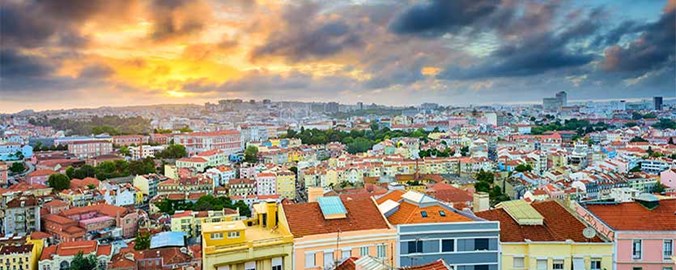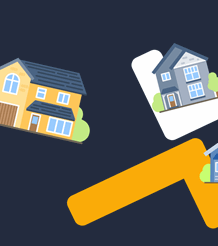
Investors after great Value for Money, Capital Gains and good Yields should head to Portugal...but stay clear of Lisbon's overheated Market
According the 2018 Global Property Guide, "Portugal’s housing prices continue to rise strongly, fuelled by surging demand as well as improved economic conditions. Property prices in Portugal rose by 4.84% (3.26% in real terms) in November 2017 from a year earlier, to an average price of €1,144 (US$1,373) per square metre (sq. m.), based on figures released by Statistics Portugal (INE)."
Portugal's house prices began their recovery in 2014, after more than three years of gut-wrenching depression.
"In Lisbon metropolitan area, property prices were up by 4.9% (3.3% in real terms) y-o-y in November 2017, to an average of €1,386 (US$1,664) per sq. m.," the latest Global Property Guide states, but house prices increased across all of Portugal's 24 urban areas, with the highest increase being recorded in Amadora, where house prices rose by 12.88% during the year to end of November 2017. Coimbra fell just slightly short off this with a rise of 12.82% in the same period, followed by Odivelas (12.62%), Oeiras (12%), Cascais (11.65%), Matosinhos (9.84%), Leiria (9.83%), Loures (9.17%), Sintra (9.01%), and Funchal (8.41%), as well as Vila Franca de Xira (7.75%), Santa Maria de Feira (7.72%), Maia (7.59%), Vila Nova de Famalicão (7.5%), Almada (7.47%), Seixal (7.22%), Gondomar (7.02%), Setúbal (6.79%), and Braga (6.75%).
According to the latest statistics, other urban areas saw only modest increases in prices:
Guimarães (5.67%), Lisboa (5.51%), Porto (5.28%), Barcelos (3.74%), and Vila Nova de Gaia (3.54%).
However, at the end of November 2017 Bloomberg reported that Lisbon's hot property market left buyers struggling to find a home; with some buyers offering above the asking price and even Madonna struggling to close a deal. In central Lisbon’s property market, the news organisation reported, "sellers are kings" due to a shortage of prime property.
"There’s a big gap between supply and demand," said Luis Tilli, a real estate agent at Lisbon-based HomeLovers. Back then they were trying to sell a three-bedroom, 236 square meter (2,540 square feet) refurbished duplex in the historic quarter of Chiado for 2 million euros ($2.38 million). "It’s reached a point where some investors offer to pay above the asking price just so they can close a deal."
By property type the picture shows that apartments are still more popular investment vehicles than villas:
Flats prices rose by 5% (3.4% in real terms) year-on-year in November 2017 Villa prices rose by 4.9% (3.3% in real terms) year-on-year in November 2017Demand is rising sharply. In Q3 2017, the total number of housing transactions grew by 23% to 38,783 units from a year earlier, while transactions values surged 34.4% year-on-year to €4.86 billion (US$5.83 billion), according to INE.
"Portugal’s property market is booming once more," enthused Chris White of real estate firm Ideal Homes Portugal. "Sales have increased hugely this year and we’ve seen a significant shift in buyer profile as increasing numbers of investors realize the potential of the Portuguese real estate sector," he added, when speaking to Global Property Guide.
With the available housing stock along Lisbon’s river Tagus falling rapidly, investors are starting to look for properties or land for development elsewhere.
"There are a very limited number of buildings located in the centre of Lisbon to purchase," said Jose Cardoso Botelho, head of Vanguard Properties, when speaking to Bloomberg at the end of last year. Vanguard are a real estate firm controlled by French-Swiss investor Claude Berda. They bought 10 buildings in Lisbon, since it began investing in the city last year. "We’ve started looking for building plots on the outskirts of the city now, but it hasn’t been easy."
Lisbon saw record investment over the last few years. House prices in Lisbon rose 35% in the period from 2012 to 2016, when they reached the highest since 2007, according to Confidencial Imobiliario, which collects data on the Portuguese real estate sector.
In Lisbon’s Old Town, property prices increased 26 percent in the first half of 2017, while the number of transactions fell 34 percent from the same period a year earlier, a sign of a shortage of housing stock. Here average property prices in the central historic neighbourhoods of Baixa, Chiado and Avenida da Liberdade stood at 6,367 euros per square meter in the first quarter, according to a study by property appraiser and consulting company Prime Yield.
Portugal is forecasting a record 3 billion euros in property investment in 2018, mostly from foreign investors. That’s up from 1.3 billion euros in 2016, according to broker CBRE Group Inc. Fuelling the demand are digital nomads like the tech start-ups that have begun to move in, as well as the likes of pop star Madonna, the latest of a handful of stars of screen and stage to show an interest in a city that’s often compared to San Francisco because of its steep hills, trams and red suspension bridge. However, housing stock in all the better market segments is running out.
Central Lisbon’s housing stock is much smaller than in other European cities such as Madrid, London and Paris, according to Luis Lima, head of Portugal’s Real Estate Professionals and Brokers Association. "It’s the first time that Lisbon has a shortage of homes to satisfy investor demand," said Lima, adding that "home buyers need to realize it’s impossible for everyone to live in Avenida da Liberdade."
When even pop stars with a budget like Madonna's can't find a home along the boulevard that's lined with gardens, luxury shops and ornately tiled pedestrian areas, the rest of Lisbon's population has little chance to find cheap Lisbon apartments or villas! Now seems certainly the time to invest in Portugal's housing market for small scale investors, as long as they stay clear of Lisbon, they should enjoy great value for money, excellent capital gains and rental returns.






